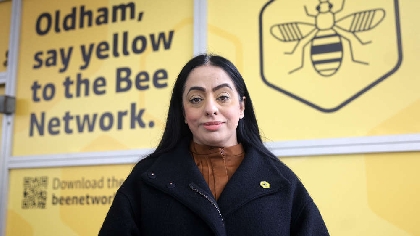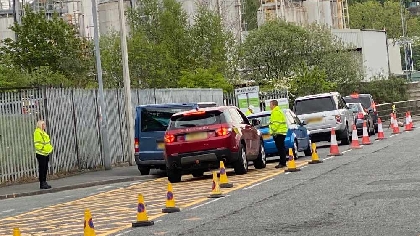
Yellow buses will now be seen buzzing through Oldham, Rochdale, Salford, Bury and north Manchester following the launch of the Bee Network’s second phase.
Greater Manchester’s vision for an integrated, accessible and affordable ‘London-style’ transport system has already been introduced into Wigan, Bolton and parts of Bury and Salford.
The Greater Manchester mayor Andy Burnham was joined by council leaders at Oldham Interchange this morning, March 25, as he announced “another historic moment” for the city-region.
Mr Burnham announced: “I caught an early service from Middleton this morning – the update I can give is that the Bee Network has landed, and it has landed pretty well.
“We have had a few delays at the Oldham depot over the launch which were only minor, nothing major, which are teething problems you would expect.
“We are really proud of the team as they’ve done a phenomenal job over the weekend and we’re grateful to our partners.
“Over half of GM buses are back under public control after four decades of deregulation and I’m sure for people in Oldham, this is a big difference as the buses here were quite old and not the best. Now they’ve got the best.
“The journey I took from Middleton to Media City was the one I took when I was first elected as mayor, and this time it was cheaper, it was under £5. Everything that we’re trying to do is make things more affordable to people.”
He highlighted that anyone left out of pocket by the change to Tranche 2 will be able to apply for the compensation scheme.
At the launch, a bus user interrupted the speeches asking why her service was over 30 minutes delayed – which later turned out to be due to the breakdown of a 409 bus, rather than a systematic fault, according to Mr Burnham’s team.
The event heard that recent data has shown services continue to be more reliable than before bus franchising and are outperforming services elsewhere in Greater Manchester.
Between January 1 and March 19, 74.30 per cent of Bee Network buses were on time, compared to 67.62 pc of commercial services and 62.75 pc for the same period last year prior to franchising.
More changes were announced for further down the line with a new “flatter and fairer” fee structure as of January 2025. This would include a £20 weekly bus pass and an £80 monthly pass as well as concession for youths.
For Oldham the key benefit of this comes in the form of better bus stock, according to council leader Arooj Shah. She explained that Oldham’s bus stock had become old and tired and was overdue this public transport improvement.
Cllr Shah said: “This is going to be huge, we have many areas that have houses with two or three cars who say they do that because we don’t have reliable transport. Once we prove to people this is more economically viable, people will use this route.
“The really exciting thing for us in Oldham is that we had a bus fleet that was really old, which meant from a public health perspective, people were breathing in polluted air. These are electrified buses now which means the air will be safer to breathe, which is a win win.”
The town hall boss added that these buses will help bring people from residential to key areas where they already have public transport infrastructure, such as the tram network. Greater frequency for “less profitable” routes that go from more residential areas is something that Rochdale’s council leader Neil Emmott is thrilled about – given his borough has some particularly rural spots.
Cllr Emmott said: “I am working with Andy to make sure some of the services reduced and lost during deregulation will be restored or improved. We’re a mixed borough because we have urban areas and rural areas, particularly in the Pennines as well as Heywood and Middleton.
So I am hoping working alongside Andy we can bring some of those back, if not all of them, and those reduced brought into greater frequency.
“The one I’m pushing for in my ward is the 167 route which goes from Norden, through Bamford then Heywood then Birch Village to Rhodes then to Manchester. Some of those have lost their links into the city centre as well as Heywood for shopping etc. I know many places have lost bus services over the years so we will be pushing for them as well.”
From April 7, five buses will be added to the V1/V2, 163, and 472/474 services and from 28 April a further 15 will be added to the 8, 10, 20/21/22, 501, 524, 575/576, 601-606, 607, 608/35, and 609 services.
The changes will initially be on a 12-month trial basis, during which punctuality improvements and associated patronage/revenue growth will be monitored, measured and evaluated to inform a decision as to whether the arrangement is extended.
Alongside physical bus routes returning, improvements are being made to the Bee Network app, which now has bus tracking for passengers to use. The new app has been downloaded over 315,000 times, and over 1.6 million journeys have been completed using app tickets.
In addition to this, are the active travel schemes that aid safer pedestrian and cycle access to public transport infrastructure. This was described as the “glue that binds everything together” by GM’s active travel commissioner, Dame Sarah Storey.
According to TfGM, since 2020 more than 109km of new walking and cycling routes, including new junctions and crossings to make it safer for cyclists and pedestrians, has been delivered. Greater Manchester’s Starling Bank Bikes provides an estimated 200,000 residents with access to bikes, and there are now more than 76,000 active users who have completed in excess of 650,000 rides covering 1.6m kilometres.
Dame Storey said: “Oldham is an excellent example of a local authority that is benefitting from the integration of the Bee Network to support the existing local work being done to enable people to walk, wheel or cycle for some or all of their journey.
The regeneration of the town centre and connections being made to local schemes like Positive Steps and Positive Cycles demonstrate what can be achieved with a joined-up vision.
“This is fundamental to the success of the Bee Network.”


 Tameside's tips now using summer hours
Tameside's tips now using summer hours
 Thief flees empty handed after attempting to mug councillor
Thief flees empty handed after attempting to mug councillor
 Sahara trekkers raise £45k for Blythe House
Sahara trekkers raise £45k for Blythe House
 Thieves targeting sheds across Tameside
Thieves targeting sheds across Tameside

